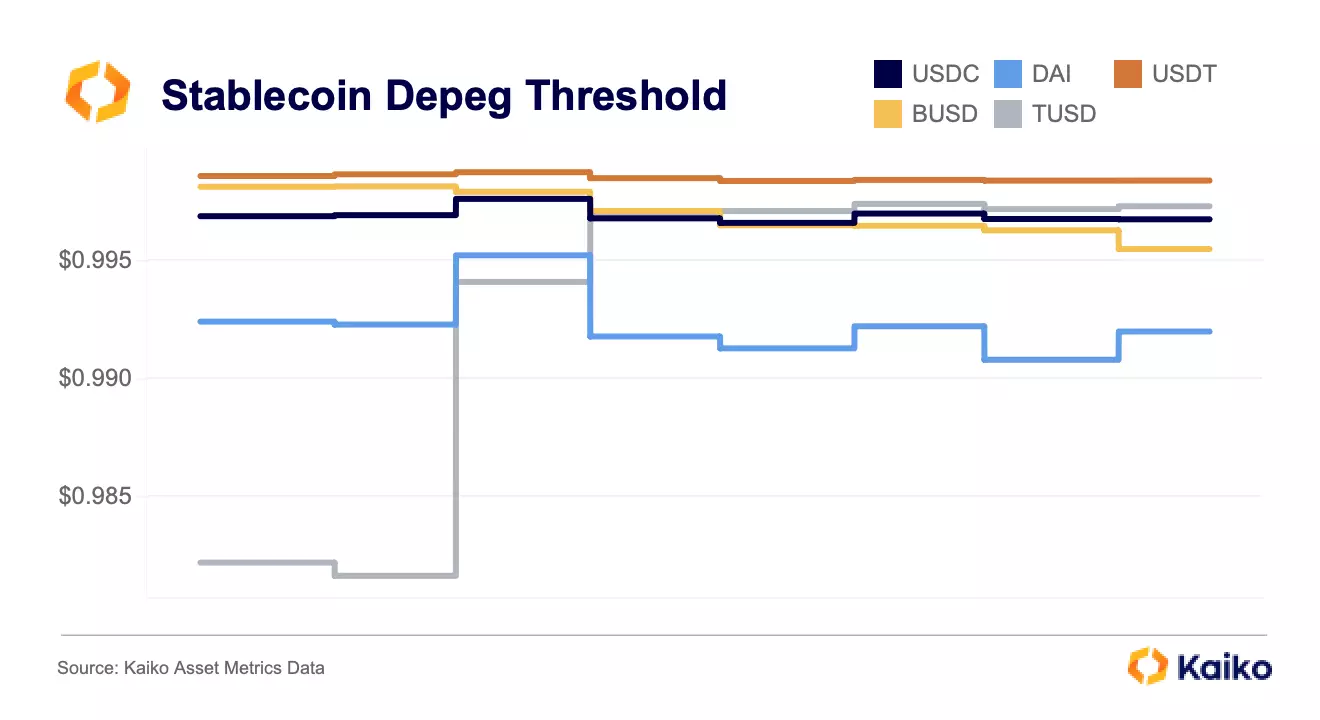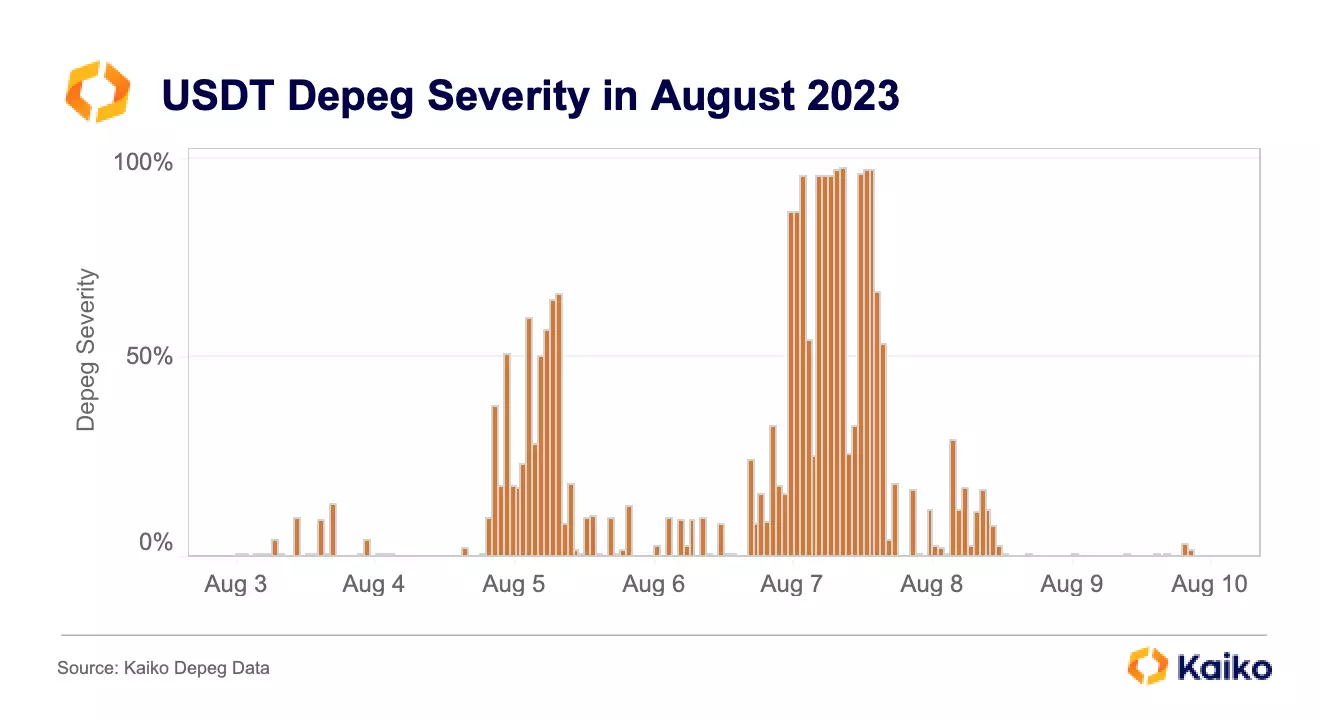Liquidity Flywheel Drives Binance to 300 Million Users

Defining Depegs: A New Metric for Stablecoin Stability

Welcome to Deep Dive!
This week we present a novel method of measuring the severity of stablecoin depegs.
-
There is currently no common standard for depegs
-
As liquidity has decreased USDT’s peg stability has suffered
-
Using volumes we are able to create depeg thresholds that are specific to each stablecoin
-
DAI, BUSD, and USDC have displayed strong stability since April
Crypto is fraught with unclear terminology: is it LSD or LST? Protocol or dApp? There’s one in particular that’s always bothered me: what is a depeg? In its simplest form, a depeg is when a stablecoin trades at a discount to whatever fiat money it’s supposed to represent. However, in the strictest and most practical terms this doesn’t really work; under this definition USD stablecoins are constantly depegging by trading tenths or hundredths or thousandths of a percent off of the U.S. dollar. The term starts to lose its meaning if we say TUSD depegged by trading at $0.99998.
So, I’ve come up with a better metric, one that uses a stablecoin’s total volume to create a depeg threshold while also assigning higher values to systemically important pairs like USDC-USDT on Binance.
Using this metric I’ve found that this year’s most severe depegs among the top five stablecoins were USDC and DAI on March 12 (obviously), TUSD on June 12, and USDT on August 7. Notably, USDT has been in a slight depeg nearly all of August. Today I’ll explain how I’ve created this metric and then explore the results.

depeg threshold
I’ve used the stablecoins’ global volumes (for example, including BTC-USDT for USDT) to create a depeg threshold that gets smaller as a stablecoin’s volume increases. The rationale here is that as a stablecoin’s volume increases, so too does the value lost from peg deviations. Put simply, a stablecoin with $10bn monthly volume trading at $0.995 is much more significant than a stablecoin with $10mn monthly volume trading at that level. I tried a few different equations and ultimately settled on:

Applied to the five stablecoins in question, we get the following results:

TUSD’s depeg threshold tightened rapidly from February to March as Binance began promoting the stablecoin by removing fees for BTC-TUSD [1]. BUSD’s threshold has widened from $0.998 to $0.9955 as its volumes have fallen. USDT has had the smallest threshold throughout, at $0.998 in August despite low volumes across all markets.
The question now becomes which instruments’ prices to use to determine whether a stablecoin has depegged. I’ve used all of them, employing the hourly Low price from Kaiko’s OHLCV data then applying a cross price to stablecoin-stablecoin pairs (stablecoin-USD pairs get a cross price of 1). This means that I’m able to create a USDT-USD price from USDT-USDC, for example. But not all instruments are equally important, thus it’s also critical to create a volume weighting component.
Never miss an analysis.
Subscribe to our free weekly Data Debrief email, or learn more about our premium research subscriptions here.
volume weighting
The chart below shows YTD stablecoin-stablecoin instrument volumes, with colors representing different exchanges [2]. DAI has the lowest volumes of the bunch at just $17bn, nearly $13bn of which was on Uniswap V3 and Curve. TUSD is next up, with just $24.5bn in volumes, $23.5bn of which came on a single instrument: TUSD-USDT on Binance.

BUSD measures in at $97.5bn and is similarly concentrated, with $93bn of that coming from BUSD-USDT on Binance. USDC and USDT look quite different from the others; USDC has $150bn in volume distributed across 48 instruments while USDT has $320bn distributed across 75.
I’ve used this to create a weighting system for the instruments. For example, in TUSD’s case, TUSD-USDT on Binance is 95% of TUSD’s stablecoin-stablecoin volumes, thus it is assigned 95 points in TUSD’s data set. USDC-USDT on Uniswap V3 is 9 points in USDT’s data set and 19 points in USDC’s data set; it accounts for more of USDC’s volume and is thus relatively more important to its peg stability than it is to USDT’s. I’ve also excluded any instrument that accounted for less than 0.01% of a stablecoin’s volume. In USDC’s case, this eliminated 15 out of 48 instruments.
The example below uses USDC to show why the weighting is so important.

Unweighted, Uniswap V2 has by far the most “depeg hours”, which is just the number of hours that USDC has dipped below its threshold on the exchange. But Uniswap V2 is not a significant driver of USDC’s stablecoin-stablecoin volume. The same is true for Binance.US, where there have been many depegs since the exchange was included in an SEC lawsuit. There were very few USDC depeg hours on Binance, yet it is the second highest in “weighted hours” because of its high volumes. Note that I’ve excluded some exchanges with suspicious volumes; a future version of this metric may exclude more exchanges.
the result
This method allows for different sensitivities to depegging. For example, looking at the beginning of August using an hourly granularity shows hours of very severe USDT depegs.

Why wasn’t this bigger news? Because the depeg wasn’t as dramatic as some past depegs in pure price terms. However, on August 7 at 8am UTC, it hit a 98% depeg severity, meaning that USDT traded at a discount on virtually every instrument. These depegs came after $500mn total net selling of USDT in just a few days on Binance, Huobi, and Uniswap. As I’ve written about previously, Tether’s redemption fee and minimum make USDT’s supply less elastic than it should be; combined with decreasing liquidity it’s not surprising to see more frequent USDT depegs.
Alternatively, it’s possible to use daily granularity for a less sensitive measure. This shows that the most severe depeg since May was TUSD on June 7, hitting nearly 60% as TUSD traded at a discount on its main Binance pair for most of the day.

I like to refer to the daily metric using depeg magnitudes, where the magnitude is just the percentage divided by 10 [3]. So, the TUSD depeg on June 7 was a magnitude 6, while the USDT depeg that came after was a magnitude 4. To stretch the metaphor further, the magnitude 5 depeg on August 7 was preceded by a magnitude 2 foreshock on August 5 and followed by magnitude 1 aftershocks the rest of the month. Like earthquakes, anything under magnitude 2.5 isn’t usually felt. USDC, BUSD, and DAI haven’t had a magnitude 1 in the last 4 months.
Finally, we can see which exchanges have been contributing the most to each stablecoin’s depegs.

Moving chronologically, it’s interesting to note that USDT barely depegged on Binance amidst the March craziness. Instead, it depegged on Uniswap V3 and Curve. June was a bad month for both USDT and TUSD. In both July and August, Bitforex has accounted for nearly all of USDC’s weighted depeg hours. Throughout the year, BUSD has been a model of stability, which may be unexpected given its NYDFS-ordered expiration date coming early next year, but isn’t surprising to anyone who has been watching its liquidity.
improvements
There are some areas of improvement for this metric that immediately stand out. The first is to remove more exchanges based on suspicious volumes. There are a few exchanges included that I’m fairly sure have significant artifiical volumes. The next would be to make the instrument weighting slightly more dynamic rather than fixed across a whole year. These are relatively minor changes that would have only small effects on the output.
Conclusion
When I first began this project I expected that TUSD would be the worst offender. Instead, TUSD has benefited from the fact that its liquidity is almost entirely concentrated on a single instrument rather than fragmented across exchanges. Meanwhile, DAI and BUSD – two very different stablecoins – have been extremely stable since April.
USDC is maybe the most interesting. It of course had a magnitude 10 depeg in March and since then has not breached magnitude 1, though it does have consistent tremors on Curve, Uniswap, and lately Bitforex. However, as USDT’s stability has suffered in August, USDC has actually become more stable, again adding to the unpredictable nature of stablecoin relationships.
USDT has a peg stability problem. Its redemption fee and minimum means it’s often rational for USDT holders to sell the token on the market rather than redeem it for USD with Tether. As liquidity has dwindled, the market is no longer able to absorb significant USDT selling. While the depegs in price terms are not huge, its consistent discount is cause for concern and could seriously erode trust if it continues. The obvious solution is for Tether to remove its redemption fee and minimum. Tether reported an $850mn profit in Q2; removing the fee would not have a significant effect on profits unless the company believes that making redemptions cheaper would significantly decrease USDT’s supply.
[1] One could argue the volume could be more dynamic, for example a monthly moving average. This raises an issue in which the threshold would shrink arbitrarily long after a significant market event.
[2] Note that I’ve opted to only focus on stablecoin-stablecoin instruments, as incorporating crypto-stablecoin pairs would have introduced too much noise into the data set.
[3] I know earthquake magnitudes use a logarithmic scale, please don’t be upset.
Data Used In This Analysis

More From Kaiko Research
![]()
Derivatives
22/12/2025 Data Debrief
Crypto in 2026, What Breaks, What Scales, What ConsolidatesCrypto markets enter 2026 in a markedly different position than in prior cycle transitions. Rather than resetting after a speculative peak, the market appears to be progressing through a phase of institutional consolidation.
Written by Thomas Probst![]()
Year in Review
01/12/2025 Data Debrief
Kaiko Research's Top 10 Charts of 2025In this report, we look back on 2025 and the key forces that shaped markets. From BTC record highs and fleeting altcoin rallies to major liquidation events and evolving regulation, we examine what shaped a seminal year for crypto.Written by Adam Morgan McCarthy![]()
Stablecoin
24/11/2025 Data Debrief
MiCA's Impact on Crypto in EuropeEurope is progressing with a conservative structured crypto framework that leans towards regulating innovation.Written by Adam Morgan McCarthy![]()
Macro
17/11/2025 Data Debrief
Navigating Fed Fears & AI Bubble BurstingGiven the current macroeconomic context, we are seeing the emergence of two major risks likely to have a decisive impact.
Written by Adam Morgan McCarthy







